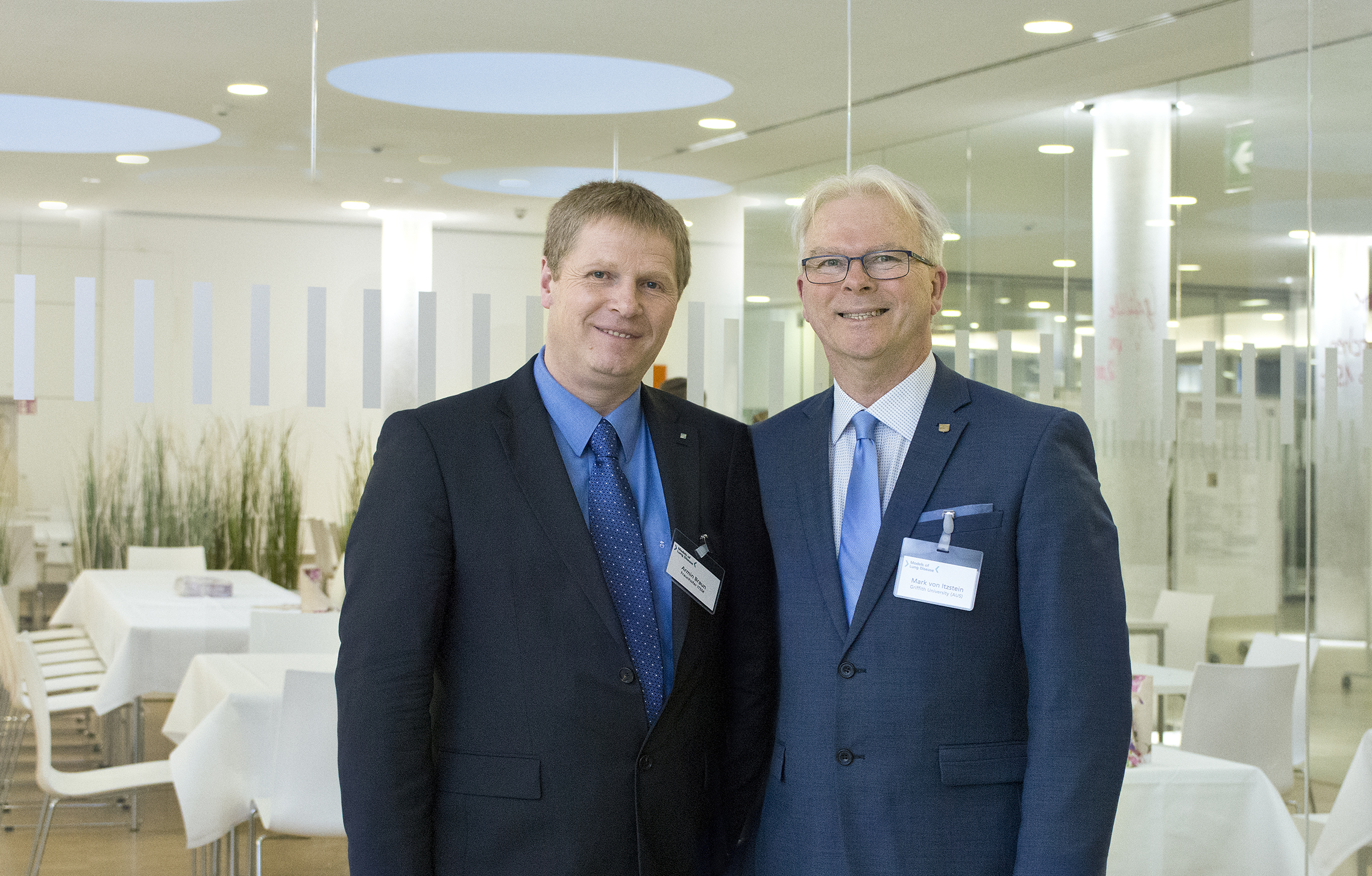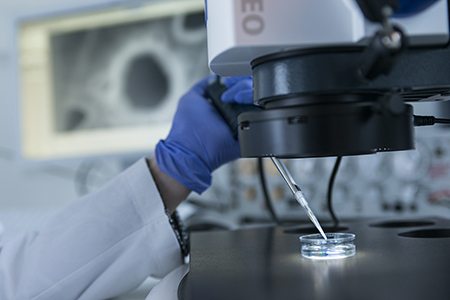International partnership in anti-infective research
Researchers from Griffith’s Institute for Glycomics have partnered with Germany's Fraunhofer Institute for Toxicology and Experimental Medicine, the Institute for Clinical Biochemistry at the Hannover Medical School (MHH), and Helmholtz Centre for Infection Research in a project called ‘iCAIR®: Fraunhofer International Consortium for Anti-Infective Research’ to develop new anti-infective drugs.
The Consortium aims to discover new treatments to combat respiratory viruses including influenza virus and respiratory infection-causing bacteria and fungi.
Infectious diseases and antibiotic resistance are a global, and potentially deadly threat. Previously effective antibiotics are becoming less and less effective against multi-resistant bacteria, and there is an urgent need to develop new drugs and treatments to combat infection.
The biggest hurdle in developing new medications is getting them from the laboratory into clinical trials, bridging the gap from the discovery of new agents to their development by the pharmaceutical industry into potential medications.
iCAIR® is working on the development of anti-infective therapies that take new treatment options all the way from the identification of potentially beneficial substances to the preclinical proof of concept. The alliance establishes a development platform that covers all the steps of a targeted drug development process, from identifying potential points of attack, right through to drug design and efficacy testing.
Joining forces to fight COVID-19
iCAIR® project enhanced to include SARS-CoV-2
The iCAIR® partners aim to develop new, urgently needed agents against infectious diseases that are gaining ground worldwide. In their development of novel anti-infectives, they go all the way from the identification of potentially beneficial substances to the preclinical proof of concept. In view of the coronavirus pandemic, the project has been enhanced to include the search for an effective drug against SARS-CoV-2.
Dr. Christoph Neubert, manager of a Fraunhofer-program, interviewed two iCAIR® project managers, Professor Armin Braun of Fraunhofer ITEM in Hannover and Professor Mark von Itzstein AO at the Institute for Glycomics, about their research activities and how they are facing the challenge of finding an effective drug.
Interview with Professor Mark von Itzstein AO and Professor Armin Braun
 Professor Armin Braun (left), Professor Mark von Itzstein AO (right)
Professor Armin Braun (left), Professor Mark von Itzstein AO (right)
(Copyright: Fraunhofer ITEM, Photographer Ralf Mohr)
Profs. von Itzstein and Braun, you are both PI’s in Fraunhofer’s international ICON project iCAIR®, a consortium between Fraunhofer ITEM, the Institute for Glycomics in Australia, the Hannover Medical School, and the Helmholtz Centre for Infection Research. What is iCAIR®?
MvI: iCAIR® is a consortium dedicated to the discovery of novel anti-infective agents to treat or prevent clinically significant diseases of the respiratory tract caused by viruses, fungi and bacteria. The consortium uses the complementary expertise from all of the partners to advance potential medicines through discovery to preclinical studies. At the end of these studies a preclinical package of data will be available for novel drug entities to advance into human clinical trials.
AB: The interesting point about iCAIR® is the possibility to join forces that are highly complementary. While Griffith University, HZI and MHH have a strong expertise in drug discovery and development, Fraunhofer brings in its knowledge in late preclinical development including regulatory GLP toxicology. iCAIR® is about developing anti-infective drugs quickly in order to bridge the so-called “valley of death” that often occurs between discovery of anti-infective drugs and clinical application.
What are the factors which make your cooperation so successful?
MvI: The consortium is very successful because of two major factors: (1) Long-standing research collaboration partnership and (2) a highly-complementary skill set in the hit-to-lead.
AB: Yes, it´s all about bringing together all the competences needed to bring a drug from the identification of targets via hit-to-lead to the non-clinical proof of concept, regarding both efficacy and safety.
You have been working together on battling lung pathogens for almost 3 years, among them being the human influenza and parainfluenza virus. Can we transfer any of the results or strategies obtained to take up the fight against the coronavirus? Is there any difference between coronavirus and other viruses? Does coronavirus require different approaches?
MvI: There is no doubt that we can learn from our experiences with our respiratory viruses such as influenza and parainfluenza virus. While these viruses are different from each other our drug discovery approach can be equally applied to all of them. Our ‘designer’ approach allows us to target specific and essential proteins in any particular virus’ life cycle and target it with our structure-informed approach. For example, in influenza virus we target the protein neuraminidase that is on the surface of the virus and is essential for virus release from infected cells, whereas in coronavirus we target, as one example, the virus’ surface protein known as the Spike protein.
AB: We have made a significant step forward in developing human ex vivo precision-cut lung slices, PCLS for short, as viral infection models. We have now established this model for influenza, parainfluenza, RSV and rhinovirus and it has turned out to provide excellent predictions about the efficacy and safety of anti-viral drugs or drug candidates. This knowledge is now used for coronavirus research. First experiments show the applicability of this approach for SARS-CoV-2 research.

The coronavirus poses an imminent threat to the health of researchers. Are you equipped to work with coronavirus at Griffith? And how is the situation at Fraunhofer ITEM?
MvI: At Griffith University’s Institute for Glycomics we have access to state-of-the-art S3 facilities that enable us to undertake both cell-based and animal studies on coronavirus.
AB: In Hannover the virus work is done in close collaboration with TWINCORE and MHH. iCAIR®-related work is performed in their S3 labs just across the road. Thomas Pietschmann and Ulrich Kalinke from TWINCORE, a joint research institute of HZI and MHH, have recently joined iCAIR® and with their extraordinary immunological and virological expertise are a perfect fit for coronavirus research.
One approach that you are following is drug repurposing. Can you elucidate on that and what candidates will you use?
MvI: The Institute for Glycomics has access to over 3,000 existing drugs that will be evaluated against COVID-19 using both primary and ex vivo, that is out-of-body, human respiratory cell-based models. This is referred to as drug repurposing, that is looking for existing drugs used in other diseases that would also be useful against COVID-19.
AB: In this project we will use substances that have been tested in different high-throughput screening approaches by Griffith University, HZI and Fraunhofer IME – Screening Port. The most promising candidates will be selected and further developed. Interestingly, this offers the possibility of an early validation of candidates, if they are selected in different screening procedures.
What makes a promising candidate? Currently there are already a lot of drug candidates mentioned.
MvI: A promising candidate is an existing drug that has good activity against COVID-19 and is safe.
AB: Yes, that would be perfect, just using a drug that is already on the market. The reality will look different: even if an existing drug is effective against SARS-CoV-2 the drug will have to be optimised for this special application. For example, it could be administered by inhalation to reach sufficient local concentrations in the airways, the main site of infection.
Many pharmaceutical companies are currently using their own molecule databanks to screen for drug candidates. What is your advantage in comparison to their approach?
MvI: Our major advantage is that we are using highly relevant human respiratory cell-based models in our screening of potential drugs. We also have an outstanding structure-informed approach that will enable further drug discovery.
Let us assume I am CEO of a big pharmaceutical company. What kind of support/contribution would you like to see from me? Or to put it in other words: How can I contribute to iCAIR® and what are you offering me?
MvI: To undertake a comprehensive screen of existing drugs and to use a structure-informed drug discovery approach is a costly exercise. We would be very much interested to join forces with pharmaceutical companies. Partnering with iCAIR® through significant financial support or in-kind contributions like performing expensive analyses such as transcriptomics would enable us to complete many human-years of work in 12-24 months.
With respect to the iCAIR® research, if you plan optimistically: What can we see in three/six months’ time from now?
MvI: In three to six months, I would expect to see enormous progress made in the identification of drug hits that could feed into the iCAIR® pipeline. By the end of six to nine months I would expect some of the first of these hits ready for extended preclinical studies to provide an appropriate data package that would enable human clinical trials to commence.
Prof. von Itzstein, you have been involved in the development of the anti-influenza drug Relenza. If you compare the development of a treatment back then to today, what has changed, what has improved and where do we still need to become better?
MvI: Much has changed in the intervening period. Structure-informed drug discovery technology has significantly improved, as has screening technology and our capacity to rapidly respond. Internationalisation of science has occurred and one may not have thought about a consortium such as iCAIR® as ever possible last century. Governments have significantly improved regulatory processes and drug fast-track approval processes now exist. The world has now shrunk due to our social and network capabilities leading to the rapid sharing of knowledge.
With respect to the next zoonotic pandemic, how can we better prepare ourselves? How do we have to equip research & developmental labs, institutes and platforms to find the right drug even faster?
MvI: It is consortia such as iCAIR® that are a real-world step in preparing ourselves for a more rapid response to zoonotic pandemics. We need to be able to rapidly respond to emerging pathogens by pooling all of our resources and knowledge.
AB: I think the key to fighting such zoonotic pandemics is to be prepared. No one can know today when the next zoonotic infection will occur or what kind of virus it will be, but we can be absolutely sure it will come. Therefore, the infrastructure for performing this research must be in place, personnel must be trained and collaborative structures must be established. iCAIR® is about meeting all these essential requirements to fight against infections.
Human precision cut lung slice model
In collaboration with our iCAIR® partners, we are employing an ex vivo human precision cut lung slice (hPCLS) model that is an ex vivo culture system to model human lung biology and disease pathogenesis.
The use of hPCLS will provide great utility in both the evaluation of potential antiviral drugs as well as in an assessment of the possible adverse impact of these drugs on host defence, for example immunosuppression.
Our fight against coronavirus
Our researchers are employing a multi-pronged approach in the battle against COVID-19
